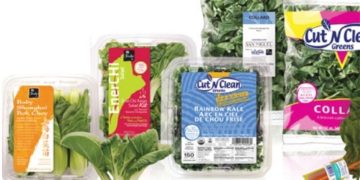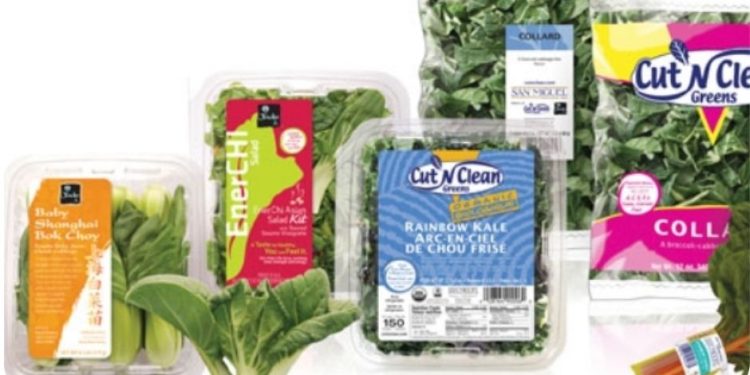Karina Magallon can remember a time less than a decade ago when San Miguel Produce needed to give away samples to try and drive orders for its fresh-cut dark leafy greens.
“Now we can’t keep up with production,” said Magallon, production manager for the Oxnard, Calif.-based company where machinery, shifts and people have all been added in the last year or two.
A Fortuitous Move
It’s been almost 20 years since San Miguel launched the first lines of washed and ready-to-cook bagged specialty greens in the United States. The company started out growing dark leafy greens as part of its commodity mix in the early 1970s, targeting the palates of Southerners and African Americans. In the 1990s, owners Roy Nishimori and wife Jan Berk made a strategic choice, based on market research, to focus their business model on a dark leafy greens niche program that included fresh-cut.
It was a well-placed move.
With greater focus on health, and juicing now on its way to being a staple in many Americans’ daily routines, San Miguel is in the right place at the right time. Operating all of its growing and processing out of Ventura County, the company is providing such crops as kale, chards, mustard greens, beet tops, baby bok choy and snow pea shoots. Selling its bunch greens under the San Miguel Produce label, its fresh-cut greens, both conventional and organic, are packaged under the Cut ‘N Clean Greens label, with Asian fresh-cut packaged greens offered through its Jade line.
According to Berk, primary market saturation is in the Midwest, Southwest and western states. Recent expansion has included national distribution, with some large national retailers and some customers in Canada.
“As we looked to expand our market into the health-focused consumer, we developed products that would also appeal to this market, such as organics, Asian, cooking kits and our new SUPER Greens Salad Series,” Berk said via email. “We want to be partners in healthy living, and our goal is to take that message mainstream.”
A Growing Niche
It becomes an easier sell every day.
“It wasn’t that long ago that no one ate Brussels sprouts or kale, but now it’s become more of a mainstream-type item,” said Brian Cook, San Miguel director of sales, noting some reports on kale’s effectiveness at battling heart disease and other ailments. “You see a lot of evolution in taste and customers’ willingness to try something different.”
“That lends itself also to the variety aspect of it. Customers are … looking for something unique and different.”
And healthy.
Consumers are not only open to sampling items like kale and various other greens, they’re willing to try them in recipes.
“People are doing kale chips, and I’ve even seen people move into collard chips to do something different,” Cook said. “You can see it in magazines, the media, the cooking shows.”
Making juice out of dark leafy greens has also heightened demand for San Miguel’s fresh-cut products.
“Kale, which has become the poster food for super health benefits, is (along with other dark leafy greens) being used in a number of ways, including juicing,” Berk said. “Whether it is the Gen-Y-ers or aging baby boomers, consumers are looking for a healthier (and tastier) alternative.”
Maximizing Quality
Magallon said the company has devoted considerable time and resources to developing systems and processes that maximize quality and shelf life – all the more important as San Miguel expands its reach.
“Internally, there’s been a lot of testing,” she said. “We go to the East Coast and that’s the biggest challenge, because sometimes it’s four to five days’ transit time.”
When commodities come from the field, they’re hydro-cooled, going from the 60˚ or 70˚ F they were in the field to 36˚ to 38˚ F and maintaining that cold temperature throughout. Some more delicate greens – curly mustard being one – require special handling.
“Right now, (shelf life) across the board is 17 days,” she said.
The company has also researched packaging, going to smaller but fuller-looking bags over larger ones.
New equipment has been installed, enabling more packing lines and shifts to meet growing demand. And food safety is paramount, Magallon said. Dark leafy greens can be harder to wash than some other commodities.
“We put kale through a whole extra-long wash system, but if we see it comes in super dirty from the field, we have to take extra steps to make sure our wash was enough,” Magallon said. “The biggest challenge is when we have rain. Fields are fields, and if it’s really muddy, we have to do a pre-wash to be sure it’s clean at the end of the line.”
Targeting Health
Berk said the company’s biggest opportunity in the years ahead is basically more of the same: “Growing consumption of fresh-cut to a nation looking to eat healthier and fight obesity.
“While this is a challenge, this is also our biggest opportunity,” she said.
Cook said San Miguel has just touched the tip of the iceberg, no pun intended.
“There are a lot of items that consumers are just barely getting to know and learning to work with,” he said. “There’s still a big opportunity nationally, targeting consumers who are looking to eat for their health, and it goes far beyond just weight management.
“We never get complacent. We’re always looking for what’s next.”
































